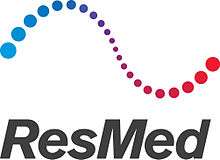ResMed
 | |
| Public | |
| Traded as |
NYSE: RMD ASX: RMD |
| Industry | Medical |
| Founded | 1989 |
| Founder |
Peter C. Farrell (Founder and Chairman) |
| Headquarters | San Diego, California |
Key people |
Michael "Mick" Farrell (CEO) Robert Douglas (President and COO) |
| Products | Medical equipment for sleep-disordered breathing and other respiratory disorders |
| Website | www.resmed.com |
ResMed is a global manufacturer of CPAP masks, machines and other products that diagnose, treat or help manage sleep-disordered breathing (particularly sleep apnea), chronic obstructive pulmonary disease (COPD), or other respiratory conditions. For the general public, the company offers a non-contact sleep monitor, the S+ by ResMed, currently available in the US.
ResMed employs about 5,000 employees worldwide, operates in 100 countries and has manufacturing facilities in Australia, France, Singapore and the US. It achieved revenues of $1.7 billion USD in fiscal year 2014–15.[1]
As part of its mission, ResMed seeks to spread awareness of the prevalence of sleep=disordered breathing (SDB) and its major manifestation, obstructive sleep apnea (OSA), since more than 80% of cases are believed to be undiagnosed.[2] More than 70% of people with obesity,[3] heart failure,[4] type 2 diabetes,[5] and drug-resistant hypertension[6] have some form of sleep-disordered breathing.
History
In 1980, Professor Colin Sullivan invented the first continuous positive airway pressure (CPAP) machine, regarded today as the “gold standard” in sleep apnea treatment. ResMed launched in 1989 when founder Peter Farrell sought to expand the general public’s access to CPAP treatment. The company was founded in Australia in 1989, but relocated to San Diego in 1990.[7] In addition to CPAP machines and masks, the company has since grown to produce CPAP humidifiers, heated tubes and other accessories, as well as diagnostic tools, hospital CPAP machines and life support ventilators. It has also expanded into healthcare informatics, with software solutions that enable patients and medical professionals to wirelessly monitor sleep data.
See also
References
- ↑ Corporate Factsheet (PDF)
- ↑ Young T et al. Estimation of the clinically diagnosed proportion of sleep apnea syndrome in middle-aged men and women. Sleep 1997;20(9):705–6.
- ↑ O’Keeffe T and Patterson EJ. Evidence supporting routine polysomnography before bariatric surgery. Obes Surg 2004;14(1):23–6.
- ↑ Oldenburg O et al. Sleep-disordered breathing in patients with symptomatic heart failure: A contemporary study of prevalence in and characteristics of 700 patients. Eur J Heart Fail 2007;9(3):251–7.
- ↑ Einhorn D et al. Prevalence of sleep apnea in a population of adults with type 2 diabetes mellitus. Endocr Pract 2007;13(4):355–62.
- ↑ Logan AG et al. High prevalence of unrecognized sleep apnoea in drug-resistant hypertension. J Hypertens 2001;19(12):2271–7.
- ↑ "Founder of ResMed to Step Down as CEO; Mick Farrell to Take Top Post", San Diego Business Journal, 20 Feb 2013